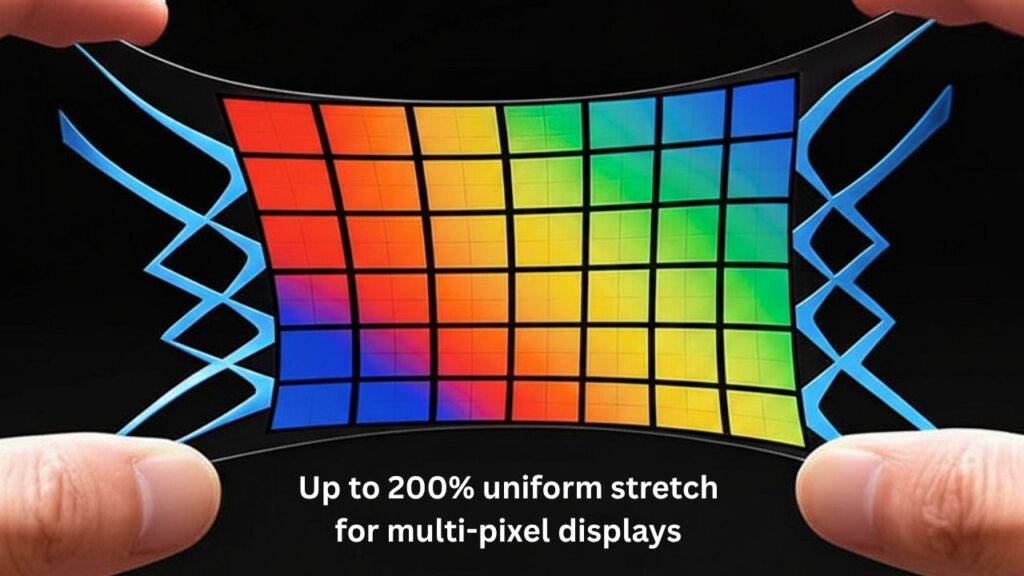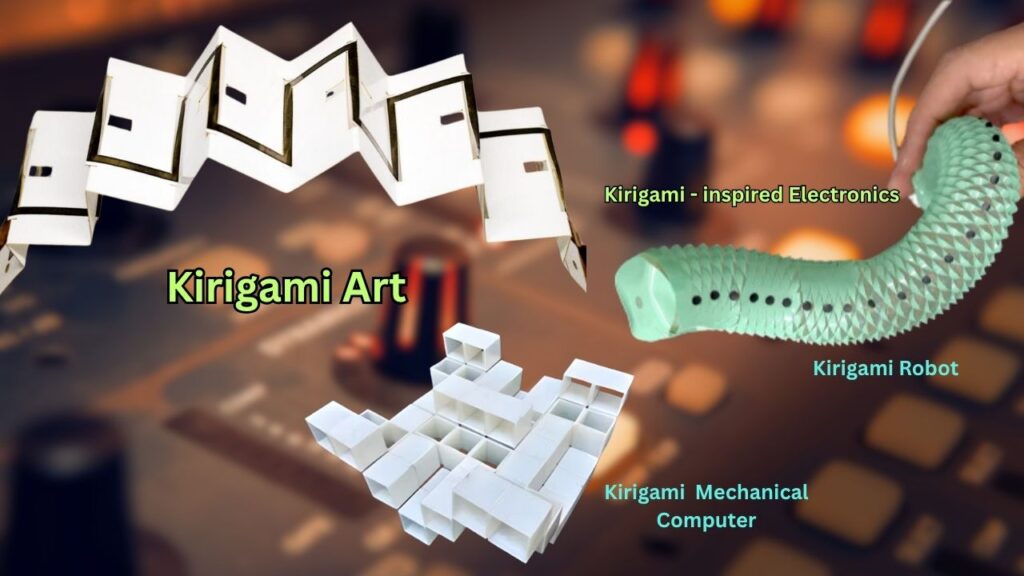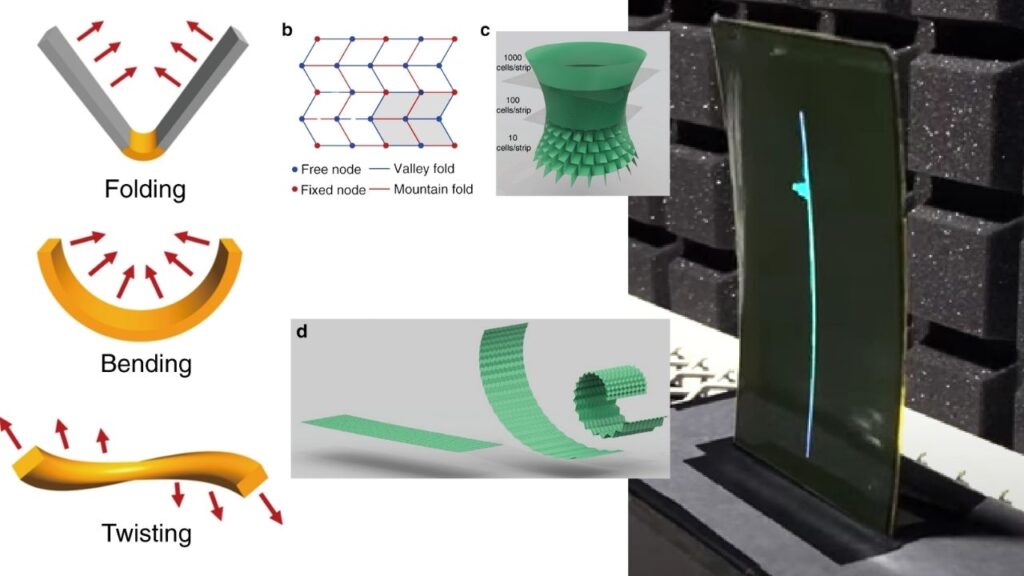Kirigami-Inspired Design Enables Uniform Multi-Pixel Displays: Imagine a TV screen you can twist, stretch, or even wrap around your arm—without the picture getting blurry or weird. This isn’t science fiction. Thanks to a breakthrough called kirigami-inspired design, scientists have created multi-pixel displays that can stretch, bend, and flex without any distortion.

In this article, we’ll explore how this works, why it matters, and what it means for the future of electronics.
Kirigami-Inspired Design Enables Uniform Multi-Pixel Displays
| Feature | Details |
|---|---|
| What is Kirigami? | An ancient Japanese art of paper cutting, now inspiring flexible, stretchable electronics |
| Stretchability | Up to 200% uniform stretch for multi-pixel displays (POSTECH) |
| Distortion-Free | Maintains clear, uniform images even when stretched or bent |
| Applications | Wearable tech, electronic skin, smart textiles, medical devices, flexible batteries |
| Key Stats | Kirigami patterns can boost material stretch from 2% up to 370% or more |
| Professional Impact | Opens doors for engineers, designers, and manufacturers in next-gen electronics |
| Official Resource | POSTECH Official Website |
Kirigami-inspired design is changing the way we think about electronics. By borrowing from ancient art, scientists have created displays and circuits that can stretch, bend, and flex without losing quality. This breakthrough opens the door to a new generation of wearable tech, medical devices, and smart textiles. As research continues, expect to see kirigami patterns powering the flexible, futuristic gadgets of tomorrow.
What is Kirigami, and Why is it Special?
Kirigami is a traditional Japanese art form where paper is cut and folded to create beautiful shapes and patterns. Unlike origami, which is just folding, kirigami adds cutting to the mix. Scientists realized that these intricate patterns could solve a big problem in electronics: how to make materials that can stretch and bend without breaking or losing their function.
How Does Kirigami Work in Electronics?

Think of a piece of paper. If you try to stretch it, it tears. But if you make tiny, carefully placed cuts (like in kirigami), the paper can open up and stretch much further. Now, imagine doing this with a super-thin sheet of electronic material. The result is a flexible, stretchable circuit or display that can move with your body or any surface it’s attached to.
Example:
Researchers at POSTECH used kirigami patterns to create the first multi-pixel display that can stretch up to 200%—that’s twice its original length—without any distortion in the image or color.
The Science Behind Kirigami-Inspired Stretchable Displays
The Problem: Why Stretchable Displays Are Hard to Make
Traditional displays—like those on your phone or TV—are made from rigid materials. Even flexible displays, like some OLED screens, can only bend a little before the image gets distorted or the pixels break. The challenge has always been making displays that can:
- Stretch a lot (not just bend)
- Keep all pixels working evenly
- Avoid color changes or blurry images when stretched
The Kirigami Solution
By making precise, tiny cuts in the display’s substrate (the base layer), kirigami patterns allow the material to stretch evenly. These cuts open up when pulled, distributing the strain across the whole surface. This means every pixel stretches the same amount, so the picture stays clear and undistorted—even when the display is twisted or pulled.

How Much Can It Stretch?
- Standard materials: Usually stretch 2–4% before breaking or distorting.
- Kirigami designs: Can stretch 200% (POSTECH’s display) and up to 370% in some conductor tests.
Why No Distortion?
The secret is uniform strain distribution. In regular stretchable displays, some pixels get more stress than others, causing uneven colors or dead spots. Kirigami cuts make sure every pixel moves together, keeping the image sharp and consistent.
Real-World Applications: Where Will You See This Technology?
1. Wearable Technology
Imagine a smartwatch with a display that wraps around your wrist, or a fitness tracker that stretches as you move. Kirigami-inspired displays can make wearables more comfortable, durable, and stylish.
2. Electronic Skin and Medical Devices
Doctors and engineers are developing “electronic skin” that can monitor your health by sticking to your body like a Band-Aid. Kirigami patterns allow these sensors to flex and stretch with your skin, making them more reliable and less likely to fall off or break.
3. Smart Textiles
Clothing with built-in screens or lights could soon become reality. Because kirigami patterns work well in textiles, you might see jackets that display messages or shirts that monitor your heart rate.
4. Flexible Batteries and Solar Cells
Researchers are using kirigami to make batteries and solar panels that can bend and stretch. This could lead to thinner, lighter devices with longer battery life.
Step-by-Step: How Are Kirigami-Inspired Displays Made?
Step 1: Choose the Right Material
Most displays use thin, flexible plastics like polyimide. Some add special coatings or layers of conductive materials (like platinum or nanowires) for better performance.
Step 2: Apply the Kirigami Pattern
Using lasers or precision cutters, engineers make microscopic cuts in the material. These cuts are carefully designed—length, shape, and spacing all affect how the material will stretch.
Step 3: Add the Electronic Components
Micro-LEDs, sensors, or other electronic parts are attached to the patterned substrate. Special techniques, like roll transfer, help connect these tiny parts without breaking them.
Step 4: Test and Optimize
Scientists stretch, bend, and twist the display to see how it performs. They use computer simulations and real-world tests to tweak the pattern for maximum stretch and durability.
Practical Advice: What Does This Mean for Engineers and Designers?
- Design for Flexibility: When creating wearable or flexible devices, consider how kirigami patterns can be integrated into your materials.
- Test Uniformity: Always check that your pixels or circuits stretch evenly. Use computer modeling to predict strain distribution.
- Think Beyond Displays: Kirigami isn’t just for screens. It can improve batteries, sensors, and even medical implants.
Satellite LiDAR and AI Enable Rapid Forest Carbon Mapping Breakthrough
Crucial Role of Quantum Science Highlighted as UNESCO Launches Global Survey
NTT Docomo Uses Quantum Optimizer to Boost 5G Resource Efficiency by 15%
FAQs About Kirigami-Inspired Design Enables Uniform Multi-Pixel Displays
Q1: What’s the difference between kirigami and origami in electronics?
A: Origami folds materials, while kirigami adds cuts. The cuts allow for much greater stretch and flexibility, which is essential for electronics that need to move or flex a lot.
Q2: Are kirigami-inspired displays already in products I can buy?
A: Not yet. Most are still in the research or prototype stage, but companies and universities are racing to bring them to market soon.
Q3: Will these displays last as long as regular ones?
A: Early tests show that kirigami displays can stretch and return to their original shape many times without damage, but more long-term testing is needed.
Q4: Can kirigami patterns be used in other electronics?
A: Yes! Batteries, solar cells, sensors, and even medical devices can benefit from kirigami’s flexibility.
Q5: Where can I learn more or see examples?
A: Visit the POSTECH official website listed in the Key Highlights table for the latest updates.
The Future: What’s Next for Kirigami-Inspired Electronics?
The possibilities are huge. As researchers improve these designs, we could see:
- Rollable TVs and tablets that fit in your pocket
- Smart clothing that changes color or displays messages
- Medical patches that monitor your health in real-time
- Flexible batteries that power new kinds of devices
Engineers are also exploring how kirigami can make electronics more durable, lighter, and even cheaper to produce.






